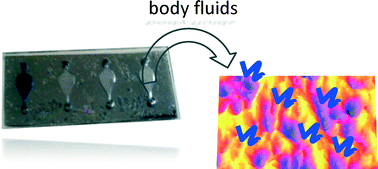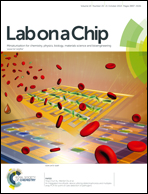OncomiR detection in circulating body fluids: a PDMS microdevice perspective†
Abstract
There is an increasing interest in circulating microRNAs (miRNAs) as potential minimally invasive diagnostic biomarkers in oncology. Considerable efforts are being made in the development of lab-on-a-chip devices for biomedical applications to purify and detect miRNAs from biological fluids. Here, we report the development of an innovative polydimethylsiloxane (PDMS)-based parallel device whose internal surface can opportunely be functionalized with positively charged 3-aminopropyltriethoxysilane (APTES) alone or mixed with two different neutral poly(ethylene glycol) silanes (PEG-s). The differently functionalized internal surfaces of the PDMS chip were characterized with s-SDTB (sulfosuccinimidyl-4-o-(4,4-dimethoxytrityl) butyrate) and the portion of the surface able to adsorb a synthetic fluorescently labeled miRNA was determined. Interestingly, the adsorbed miRNA (both synthetic and cell supernatant-derived) was found mainly on the bottom surface of the chip and could be reverse transcribed into cDNA directly on the same PDMS chip used for its purification, saving hours with respect to the use of standard purification kits. We identified 0.1% APTES/0.9% PEG-silane as the most efficient PDMS functionalization to capture both synthetic and extracellular miRNA. Moreover, the amount of captured miRNA was increased by treating the cell supernatant with a commercially available lysis buffer for RNA extraction. We assessed that the available miRNA binding sites on the functionalized surface were efficiently saturated with only one incubation, shortening the time and greatly simplifying the protocol for miRNA purification from biological samples. Finally, the extracellular miRNA purification efficiency of the PDMS functionalized multichip determined via real-time quantitative polymerase chain reaction (RT-qPCR) was confirmed by droplet digital PCR (ddPCR) quantification. This work shows an innovative, rapid and easy to use microdevice for the purification and reverse transcription of circulating miRNAs, approaching the realization of diagnostic and prognostic oncomiR-based assays.


 Please wait while we load your content...
Please wait while we load your content...